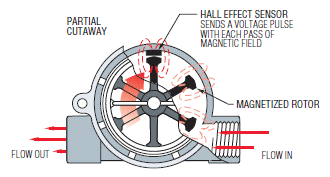RotorFlow® Operating Principle

- As liquid passes through the RotorFlow® body, the magnetic rotor spins at a rate proportional to flow. This causes a series of magnetic fields (the rotor vanes) to excite the Hall Effect sensor, producing a series of voltage pulses.
- The output pulses (RFO) are at the same voltage level as the input (4.5-24 VDC) with a frequency proportional to the flow rate. The output signal can be utilised by digital rate miters totalisers or other electronic controllers. RFA Type analog sensors condition the output signal to 0-10 VDC.
- RotorFlow® indicators may be mounted with flow entering either port. Performance is optimised by positioning ports at the top of the unit, in a horizontal plane.